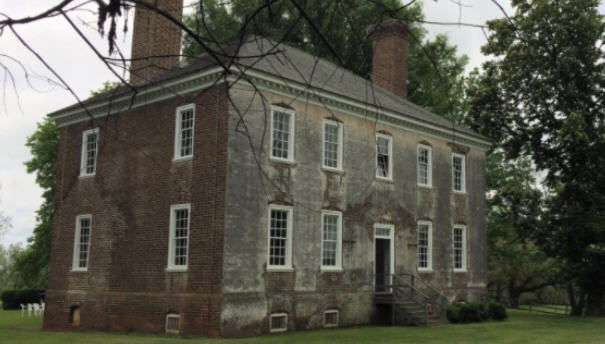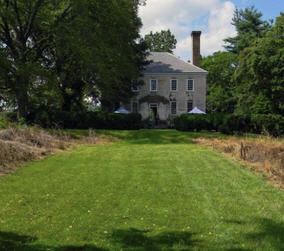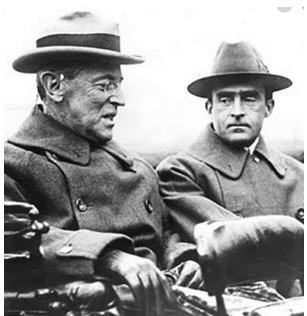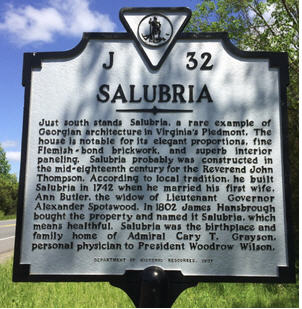A Salubrious Birthday

(This brick manor house, named “Salubria” is the oldest brick home in Culpeper County. Just a fair walk east from Refuge Farm, or Wicked Bottom, if you are walking west).
It is the 70th anniversary of my presence on this earth. This morning, I can say that I survived the ’60s- twice. A brief note of thanks to those with whom I had a chance to share astonishing times while still upon it. What a blast!
Accordingly, the weeks before the 70th harnessed the evoked energy to apply some facelifts to Refuge Farm. The labor was conducted by an assortment of internal and external working parties with discrete skills. That included overlapping task teams, some cleaning inside while others destroyed things outside as still others rebuilt parts of the exterior deck. To avoid looking at actual physical labor, I worked on the Marquis story to plow back to another war in these parts that doesn’t have Lee or Grant in it. I was only mildly surprised to see that was only one of them.
In so doing, I was following the lines of march on GoogleMaps that brought his troops together near where the farm is today.
I ran across references to Stevensburg, the unincorporated town two miles east of the Farm. I was last there investigating the perimeter of that big solar farm they wanted to plant here. Tht was the most recent battle. It was interesting to see it, close up, since it is normally observed in a blur at a speed of more than sixty knots going east or west. It is about seven miles from downtown Culpeper, a town surveyed by a young man named Washington. There is more to remember, apparently.
Stevensburg was originally called York by the optimists who came here from somewhere else. Local sources claim they were doughty Quakers. The year after the Marquis passed through in 1782, the community renamed it “Stevensburg” in honor of General Edward Stevens, a Culpeper Revolutionary War hero who led the local chapter of the Culpeper Minutemen. They say that travelers often camped in the small ravines that snake though the verdant greenery. They were called “bottoms,” which is something we have adopted to speak of the lower pasture at the juncture of our streams. But of course there is more to the term.
A half mile east of Stevensburg, or a particularly brisk hike from the Farm, there is a bottom on the south side of Route 3. In its time, it gained some notoriety and fame for lewd public behavior (according to the Quakers) and came to be known as Wicked Bottom.
Had we known that before the formal christening of the farm, imbued with rectitude at the sordid behaviors of DC, we would have adopted it. Or at least embraced it.
There is a modest rise about a mile east of the village. During the winter of 1863-1864, Hansbrough’s Ridge hosted Grant’s Union Army winter encampment in preparation for the Overland Campaign to Petersburg and the capture of Richmond. You can imagine there was a fair amount of emotion that did not completely dissipate. They say there are a lot of ghosts here abouts.
Some of the literature about the village is colorful. Some describe “eerie streets, abandoned places, and extensive history.” If you are of a paranormal bent, you may consider Virginia to be one of the more haunted states out there. And that’s especially true about Stevensburg. Most all of its haunted allegations, at least the ones not involving our real property, revolve around Salubria. The quick version is of two young men who were dispatched to fetch something and encountered a woman dressed in black, beseeching them with outstretched pale arms. I don’t know about anything since, but there are others looking.

Reverend John Thompson, the rector of the Little Fork Church from 1740 to 1772, built the place as a testament of love for a woman he sought to marry. In part, Refuge Farm shares the origin story. Thompson’s erection lasted longer, as does the story of their union. The popular name of the manor comes from the next set of owners, though, and refers to the health of those who reside within. “Salubria.”

The story goes like this: At his death in 1740, Virginia’s first colonial Governor Alexander Spotswood left a widow named Butler Brayne Spotswood. Through the family tangles, she is thus also related to Spotswood descendent Robert E. Lee.
Reverend Thompson of the Little Fork Church longed to make this widow his wife and was crushed when she first rebuffed his advances due to lack of suitable station in the colony. Undaunted, he appealed directly to Lady Spotswood, imploring her favor with fervent entreaty. His way with words went like this:
“Now, if I can make it appear that the ministerial office is an employment, in its nature most honorable and in its effects most beneficial to mankind, I hope your objections will immediately vanish and that you will keep me no longer in suspense and misery, but consummate my happiness.”
Signed by the Reverend John Thompson, May 1742
The Reverend had worked his magic. They were wed on November 9, 1742 and later lived at Salubria.
The manor house was constructed in formal Georgian style at a time when Culpeper County was still on the frontier. Although the precise date of construction is not certain, Salubria dates to around 1757 as the residence of Reverend Thompson and his new wife. We don’t think much about the land east of the Shenandoah as being “frontier,” but it was. Bricks used to build Salubria were still warm in 1759 when the word spread of trouble down south. Cherokee attacks in the Catawba and Yadkin River valleys drove North Carolina colonists from their homes and farms.
These days, I am supposed to insert some sort of condemnation of one party and victimization of another. I won’t bother. But among the refugees from indigenous violence, Daniel Boone brought his whole family on a 200-mile walk northwest to sanctuary with friends in Culpeper County. They happened to be in Stevensburg, near freshly minted Salubria. Dan worked as a tobacco teamster hauling product from the fields here east to Fredericksburg across the Rappahannock River, via Germanna Ford. Local word is that some of that family still is here.
Salubria’s name is younger, and dates to James Hansbrough, who bought the place in the early 1800s. He considered the Latin word for ‘health’ to be appropriate. Salubria.
The manor is a striking place, shouting messages from another age. Almost all of them, in fact. They resound from the humans who worked this rich land and those who enjoyed their religion and some who enjoyed their wicked ways. Salubria’s exterior is framed by two unusually tall corbel-capped chimneys, enclosed at each end of a hip roof. Front and rear facades are identical brick laid in Flemish bond, three sides stuccoed and one plain brick. The last is a manifestation of an incomplete dream along the way. There were several. Over time, the property came to the Grayson family. Sarah Mason Cooke Grayson was the product of colonial genetic sprouts that included her grandfather, George Mason of Gunston Hall. There was a time I tried to visit some of the great estates that survived to the present day. Salubria wasn’t on the list, but it should have been. Culpeper is a place people crossed, going somewhere else.
On a birthday, I think I prefer just being here.

(President Wilson, a current hot topic in terms of public policy and Presidential succession, with his Doctor, Admiral Grayson).
A later famous resident was a Navy doctor, Admiral Cary T. Grayson. Born at Salubria in 1878, he became Presidential Physician to Presidents Teddy Roosevelt, William Howard Taft and Woodrow Wilson. You can imagine the excitement of that last role after Mr. Wilson was struck down by stroke in 1919, largely incapacitated but serving with his wife Edith’s guidance until 1921. Admiral Grayson was later Director of the American Red Cross and is buried on the property with his family.
So, there is some lineage and connection here, both with the historic figures of their ages, the winds of war and family members who walked its soil. I looked for the Lady in Red, our meteorological expert. She predicts a gray day with rain. I had intended to cheat and drive east to see Wicked Bottom, and see if any unexpunged vitality remains. I guess that will have to wait.
You are lucky you didn’t get me started on our unincorporated village. Winston has got some history, too.
Copyright 2021 Vic Socotra
www.vicsocotra.com

Salubria: Donated October 2000 by Laura N. Grayson, widow of J. Gordon Grayson, to the Memorial Foundation of the Germanna Colonies in Virginia. Placed on the Virginia Historic Landmarks Register in 1969 and on the National Register of Historic Places in 1970.
